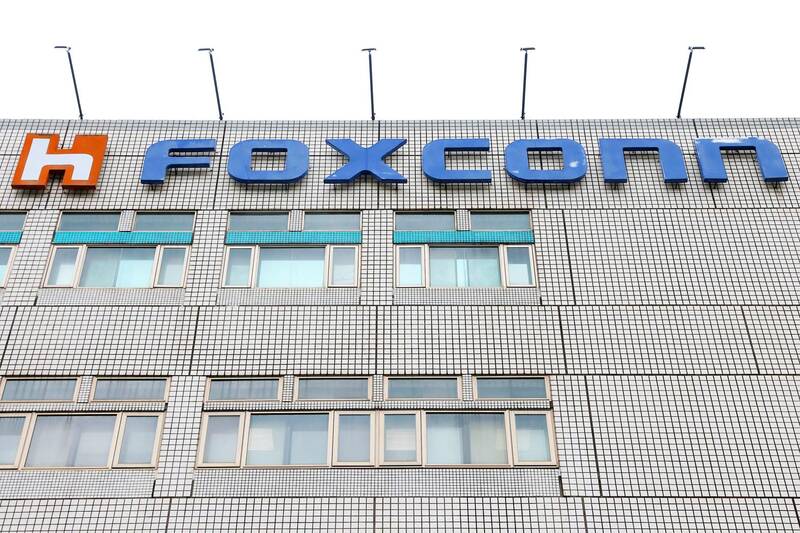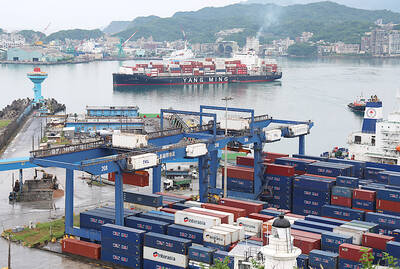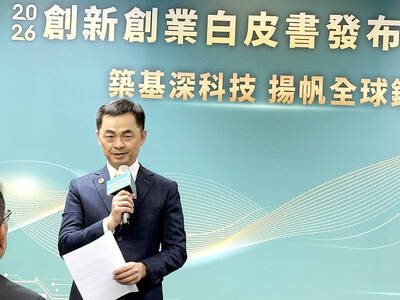The lockdown of Foxconn Technology Group’s (富士康科技集團) Zhengzhou factory, which is the world’s largest producer of iPhones, has highlighted some of the risks of relying on China’s manufacturing sector amid its ‘zero COVID’ policies, analysts said.
Foxconn — known as Hon Hai Precision Industry Co (鴻海精密) in Taiwan and Apple Inc’s principal subcontractor — has seen a surge in COVID-19 cases at its Zhengzhou site, leading the company to lock down the vast complex in a bid to keep the virus in check.
Images soon after emerged of panicking workers fleeing the site on foot in the wake of allegations of poor conditions at the facility, which has hundreds of thousands of employees.

Photo: Carlos Garcia Rawlins, Reuters
Foxconn is China’s largest private-sector employer, with more than 1 million people working across the country in about 30 factories and research institutes.
However, Zhengzhou is the Taiwanese giant’s crown jewel, churning out iPhones in quantities not seen anywhere else.
“In a normal situation, almost all the iPhone production is happening in Zhengzhou,” Counterpoint analyst Ivan Lam (林科宇) said.
Apple manufactures more than 90 percent of its products in China, which is also one of its most important markets.
“For Apple, it is once again a bad example in terms of the stability of production chains,” Natixis SA Asia-Pacific manager Alicia Garcia Herrero said.
The company’s heavy dependence on China “brings potential risks, especially when the US-China trade war shows no signs of de-escalating,” consulting firm Dezan Shira and Associates said.
Opened in 2010, the Zhengzhou factory employs up to 300,000 people who live on-site throughout the year, creating a sprawling tech hub known as “iPhone city.”
It is made up of three factories, one of which produces the iPhone 14 — Apple’s newest handset model.
Lam said that the partial stopping of work at the site resulted in a loss of “10 to 30 percent” of output, adding that part of the production has been temporarily moved to other Foxconn sites in China.
The site is currently operating a “closed loop” with the workers avoiding all contact with the outside world, while their daily bonuses have been quadrupled, Foxconn said.
“This incident may have a limited impact,” on worldwide iPhone production, said TF International Securities Group Co (天風國際證券) analyst Kuo Ming-chi (郭明錤), who specializes in Apple products.
“But suppliers in China must learn to improve closed-loop production efficiency in response to the ‘zero COVID’ policy,” he added.
China is the last major economy committed to a ‘zero COVID’ strategy, persisting with snap lockdowns, mass testing and lengthy quarantines in a bid to stamp out emerging outbreaks.
Highly transmissible variants have tested local officials’ ability to contain outbreaks faster than they can spread, causing much of the country to live under an ever-changing mosaic of COVID-19 restrictions.
Before the COVID-19 pandemic, Apple had begun outsourcing part of its production to India, and is considering Vietnam in a bid to wean itself off Chinese manufacturing. The pandemic accelerated the process.
The transition could take a while. Last year, nearly 7.5 million iPhones were made in India, just 3 percent of Apple’s total production.
“Increasing the capacity of factories [in India] is difficult,” Lam said.

CHIP RACE: Three years of overbroad export controls drove foreign competitors to pursue their own AI chips, and ‘cost US taxpayers billions of dollars,’ Nvidia said China has figured out the US strategy for allowing it to buy Nvidia Corp’s H200s and is rejecting the artificial intelligence (AI) chip in favor of domestically developed semiconductors, White House AI adviser David Sacks said, citing news reports. US President Donald Trump on Monday said that he would allow shipments of Nvidia’s H200 chips to China, part of an administration effort backed by Sacks to challenge Chinese tech champions such as Huawei Technologies Co (華為) by bringing US competition to their home market. On Friday, Sacks signaled that he was uncertain about whether that approach would work. “They’re rejecting our chips,” Sacks

Taiwan’s exports soared 56 percent year-on-year to an all-time high of US$64.05 billion last month, propelled by surging global demand for artificial intelligence (AI), high-performance computing and cloud service infrastructure, the Ministry of Finance said yesterday. Department of Statistics Director-General Beatrice Tsai (蔡美娜) called the figure an unexpected upside surprise, citing a wave of technology orders from overseas customers alongside the usual year-end shopping season for technology products. Growth is likely to remain strong this month, she said, projecting a 40 percent to 45 percent expansion on an annual basis. The outperformance could prompt the Directorate-General of Budget, Accounting and

NATIONAL SECURITY: Intel’s testing of ACM tools despite US government control ‘highlights egregious gaps in US technology protection policies,’ a former official said Chipmaker Intel Corp has tested chipmaking tools this year from a toolmaker with deep roots in China and two overseas units that were targeted by US sanctions, according to two sources with direct knowledge of the matter. Intel, which fended off calls for its CEO’s resignation from US President Donald Trump in August over his alleged ties to China, got the tools from ACM Research Inc, a Fremont, California-based producer of chipmaking equipment. Two of ACM’s units, based in Shanghai and South Korea, were among a number of firms barred last year from receiving US technology over claims they have

BARRIERS: Gudeng’s chairman said it was unlikely that the US could replicate Taiwan’s science parks in Arizona, given its strict immigration policies and cultural differences Gudeng Precision Industrial Co (家登), which supplies wafer pods to the world’s major semiconductor firms, yesterday said it is in no rush to set up production in the US due to high costs. The company supplies its customers through a warehouse in Arizona jointly operated by TSS Holdings Ltd (德鑫控股), a joint holding of Gudeng and 17 Taiwanese firms in the semiconductor supply chain, including specialty plastic compounds producer Nytex Composites Co (耐特) and automated material handling system supplier Symtek Automation Asia Co (迅得). While the company has long been exploring the feasibility of setting up production in the US to address